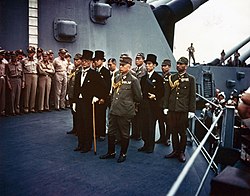Mamoru Shigemitsu
Mamoru Shigemitsu | |
|---|---|
重光 葵 | |
Shigenori Togo | |
| Personal details | |
| Born | July 29, 1887 Yugawara, Kanagawa, Japan |
| Alma mater | Tokyo Imperial University |

Mamoru Shigemitsu (重光 葵, Shigemitsu Mamoru, July 29, 1887 – January 26, 1957) was a Japanese diplomat who served as Minister of Foreign Affairs three times during and after World War II and as Deputy Prime Minister. As a civilian plenipotentiary representing the Japanese government, Shigemitsu cosigned the Japanese Instrument of Surrender on board the battleship USS Missouri on September 2, 1945.
Early life and career
Shigemitsu was born in what is now part of the city of
Pre-war
Following the
During the
Shigemitsu later became ambassador to the
World War II
Shigemitsu was highly critical of the foreign policies of
Shigemitsu's many attempts to stave off
On April 20, 1943, in a move that was viewed as a sign that Japan might be preparing for a collapse of the
From July 22, 1944, to April 7, 1945, he served simultaneously as Minister of Foreign Affairs and
Shigemitsu, as civilian plenipotentiary, along with General Yoshijirō Umezu, signed the Japanese Instrument of Surrender on board the battleship USS Missouri on September 2, 1945.
Post-war
Despite Shigemitsu's well-known opposition to the war, at the insistence of the Soviet Union, he was taken into custody by the
He was sentenced to seven years in prison, the lightest punishment that was handed down to anyone convicted at the trial. He was paroled in 1950.
After the end of the
The cabinet continued after the merger of the party and the
Shigemitsu concurrently served as
The following year, Shigemitsu addressed the United Nations General Assembly, pledging Japan's support of the founding principles of the United Nations and formally applying for membership. Japan became the UN's 80th member on December 18, 1956.[10] Shigemitsu also travelled to Moscow in 1956 in an attempt to normalize diplomatic relations and to resolve the Kuril Islands dispute. The visit resulted in the Soviet–Japanese Joint Declaration of 1956.
Death
In January 1957, a year after his visit to the Soviet Union, Shigemitsu died of myocardial infarction at 69 in his summer home in Yugawara, Kanagawa.[11]
References
- ISBN 978-1538111567.
- ^ "Jap Officers Hurt By Bomb Explosion", The Bismarck Tribune, April 29, 1932, p. 1; USSMissouri.com Archived September 27, 2007, at the Wayback Machine
- Toland, The Rising Sun. Random House, New York (1970) [ISBN missing]
- ^ "Jap Cabinet is Shaken Up", Nevada State Journal, April 21, 1943, p. 1
- ^ "Shigemitsu, Mamoru", Current Biography 1943, p. 692
- ^ Shigemitsu, Mamoru (1958). Japan and Her Destiny: My Struggle for Peace. New York: E.P. Dutton & Co. pp. 319–320.
- ISBN 1-935456-03-2p. 297
- ISBN 978-0674984424.
- ISBN 978-0674984424.
- ^ NHK "Sonotoki" transmission 305 of November 14, 2007
- ^ "Mamoru Shigemitsu, 69, Dead; Surrendered for Japan to Allies; Former Foreign Minister Was Imprisoned for War Crime – Led Nation Into U.N. Made Peace Overtures Entered Foreign Ministry Tried With Tojo". The New York Times. January 26, 1957. Retrieved August 15, 2020.
Sources
- Shigemitsu, Mamoru (1958). Japan and Her Destiny: My Struggle for Peace. F.S.G. Piggott (editing), Oswald White (translation). New York: Dutton. OCLC 1069057234.
- Archive Footage references to Shigemitsu at Internet Movie Database [1]
- Website on exhibition in Japanese Parliament Nov 8–30, 2007 [2], accessed November 14, 2007
